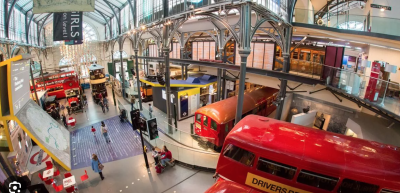British History: Impacts on the Environment
July 18, 2023
After an eventful day of sightseeing, scavenger hunting, and distinctively British experiences, our second day of UK programming saw us take a trip to London’s fantastic Docklands and Transportation Museums. Each of these institutions holds an extensive overview of the trade, industry, and transportation that shaped both the British Empire and countries across the world. This day was equally fun as it was informative, providing a plethora of information about the history of urban transportation and the vast social and environmental consequences of British colonization and industrialization.
Our first stop was the Docklands Museum, nestled in Canary Wharf, now one of the world’s primary financial centers, in a repurposed warehouse of the West India Docks dating back to 1802. As we took the elevator to the beginning of the exhibitions, we were transported back in time to the height of London’s dock operations, the beating heart of the British Empire. Model equipment, sailors, and even a startling mummified cat provided a look into 19th-century dock operations and working conditions. The logistics behind how massive amounts of goods were loaded and unloaded with little technical help were fascinating and brought perspective to the scale of worldwide trade and globalization during this period. Later on, the museum even had walk-through sets and actors that recreated the life of a British sailor. The rest of the exhibits took a different tone, discussing Britain’s legacy of cash crops, exploitation of native populations, and the triangular slave trade. Immersive displays and detailed descriptions discussed the appalling atrocities and injustices the British built their wealth upon. Most know of the lasting, devastating effects slavery had in Africa and across the globe, but the exhibits truly immersed us in history, broadening our perceptions. British industrialization was both socially and environmentally unsustainable, setting a standard that has led to many of our world’s current crises. Considering this context and the inequalities it caused will be crucial to form environmental justice efforts that address longstanding issues to create a more sustainable, equitable future.
For lunch, we got the chance to explore London’s beautiful Covent Garden market before heading to the adjacent Transportation Museum. London is iconic for its public transportation system, and it adds insightful examples to our program’s overview of urban mobility. The museum used descriptions, visuals, and countless original buses, trains, taxis, and memorabilia to tell the story of London’s hundreds of years of transportation innovation. Lucky for us, we had UNC alum Audrey Bowerman with us to guide us and provide anecdotes from her years working on mobility in London. The world has come a long way from the horse and carriage, and the museum showed every step of the process. Connecting the entire city with fluid, comprehensive intermodal transportation took decades, but allowed for many learned lessons. Although a lot of cities have surpassed the UK system, this museum still provided amazing examples of quality transportation infrastructure. Most large cities and metropolitan areas in the US lack quality transportation, and this museum taught us much about the key techniques to secure accessible, effective urban mobility.
These museums embody the role that history plays in society. Their accessible, well-designed, and entertaining exhibits showcase what we must learn and respond to from England’s history. From battling enuring injustices to revolutionizing US urban transportation infrastructure, there is plenty of opportunity for each of us to do our part in making the world a more sustainable place.
About the Author
This article was written by Kyle Daniels, Class of 2026, majoring in Environmental Science and Economics
